Nandigram : A Report
Gautam Ghosh
March 28
I had the opportunity of visiting Nandigram with a relief team on March 25. Since I was not
involved in the actual distribution of the relief, I will confine my report to what I have seen
and heard. A separate report from the organizers will give you the details of the relief
effort.
I felt like going to a battlefield when a student insisted on putting a sticker on the
windscreen describing us as a relief team and another student thrust a copy of a high court
order in my hand which will presumably prevent us from being held up or at worse being
beaten up. It was a three and a half hours journey most of it over good and well maintained
road. Up to and including Nandigram you do not see or feel anything out of the way; life is
going on as it always goes in its own rhythm. The picture changes in Maheshpur. We sit in
a road side tea stall and one by one people trickle in. Spontaneously they tell us about their
travails: how they were beaten up by police and cadres ( the name harmad has gained
currency here) on March 10. Apparently there was an altercation between the Pradhan and
the villagers about the school being closed for so long. The Pradhan went back and sent in
his henchmen together with the police who did not discriminate between men and women
or between people in the streets , shops or in their homes in meting our chastisement. The
stall owner, a middle aged village woman had her share of the beatings as did several others
in the group. Since then the peace is gone and every night they hear sounds of gunfire and
exploding bombs. Their defence consists in their determination in not parting with their
land and surprisingly a multinational product: mobile technology. Just then a message came
on the air wave informing the assembly of a thousand men with motorcycles at Thekhali
and an impending attack at 3pm that very afternoon. I felt apprehensive but the calm
resignation with which the news was received by the people around was a morale booster.
The women in my group were interested in visiting some of the affected village women in
their homes. They did so in a nearby place called Parulbari while we waited on the road and
got to hear essentially the same story from the assembled men. An old widow with quite a
dignified appearance narrated the state of affairs with surprising detachment. She had a bit
of land which fell within the notified zone. It was she who pointed out to me a peasant
woman with a splinter wound in the arm. The victim was participating in the Gourangapuja
held in Bhangabera during the infamous 14th March incident.
Time was passing and we hurried on to Sonachura. The road took a sharp turn before
Tekhali bridge and from then on it was a red moram affair but quite motorable. Thekhali is
enemy territory and therefore a no go area for us. Only two days back a woman went to the
bazaar in Tekhali to buy kerosene and was so severely beaten up that she had to be
admitted to hospital. There is a school in Sonachura and a NGO has opened a clinic there. I
asked the doctor about the number of wounded he has attended and the kind of problems
involved. He said that in two days he treated about a hundred patients and that most had
eye problems. He was suspicious about the nature of the gas shells as effects of tear gas do
not normally persist after a day or two. A villager with a wound in the foot insisted on
showing us the carnage site that is the Bhangabera bridge. It was a straight metalled road
with a deep trench cutting it in half. Elsewhere we had driven over culverts which were cut
and then crudely repaired. But this trench takes the cake; not even a tank could cross it. The
field on one side was strewn with paper plates and the road itself bore distinctive marks for
some distance. According to the villager they were blood marks from the fleeing crowd and
the paper plates bore testimony to a victory feast.
The bridge was full of high power activity. A posse of high ranking police officers with
jeeps and pilot cars and of course their gun toting protectors had come on some
investigation (we met them again near Tekhali bridge while returning). The Khejury side of
the bridge was deserted but for an old man and a peasant woman. They were not very
communicative. It took some questioning from us to extract that they were being
persecuted for supporting land acquisition. Since there was nothing more to do we
recrossed the bridge after counting the bullet marks on a wall (encircled and coded H1 to
H18). Evidence of the bloody affair were still lying around. A small boy showed us a fence
with smears of blood on it, a ball of hair at the site of the Gourangapuja, torn gloves used
probably by the forensic experts etc. He also pointed out a house and said that a girl was
raped there. He had witnessed the unsavory side of life at too early an age and for him the
innocence of childhood is over. Here the people were more voluble and readily came out
with stories of their sufferings. Living on the frontier so to say I could see that they had a
precarious existence.
Back to Sonachura and we are led to the next hamlet called Gangra to visit the house of a
victim of the firings of March 6. Rinku Mandal wife of the murdered Bharat Mandal has
three small children, a thached house and no land as Bharat was a daily laborour. We
inquired at the local relief center and they readily explained their mode of operation. How
much rice, lentils, money and other necessities were given to each family of the victims,
how the books were maintained and so on. It was heartening to know that the distribution
was done efficiently and equitably. Mean while our relief team had not yet finished their
task. They had a hard day, buying a mountain of foodstuff at the Nandigram bazaar and
transporting it on a hired vehicle to the relief centers in different villages. Siddiqullah had
come and his harangue attracted villagers from all around. We decided to leave
immediately as otherwise his meeting might block the only road out of Sonachura.
It was a long day and while driving back I was trying to shift through the volumes of
information about so many people killed, wounded and missing. It would take a long time
to ascertain the facts but who will do it? The administration is nonexistent, it dares not
show its face without armed escorts as we had already witnessed and besides it is not
trusted. The people are united for their land and are resigned to sacrifice more blood if
necessary. The economy of development needs cheep land and the cheapest land belongs to
the poorest people. A community will be obliterated , the people will go into oblivion so
that the share market can boom. I entreat my readers to go to Nandigram and spend a few
hours with the people there. They are eager to talk to you and it would comfort them to
know that the outside world has not forgotten them. Consider it an outing for a day and the
money you spend for refreshments or the transport you use will surely help the local
economy.
Download PDF report
Surasri Chaudhuri
1st April, 2007
A visit to Nandigram along with a Medical Team on 31st March 2007.
Recently I had the opportunity of visiting Nandigram twice, within an interval of 6 days,
on 25th and 31st March. Here is an effort aimed at sharing my experience with friends.
After that fateful day at Nandigram, 14th of March, many medical support teams as well
as human rights organizations visited the area. From their reports, as well as some media
reports, we came to know of the severe trauma, both physical and psychological, suffered
by the people of Nandigram, especially women. Some friends of mine, mainly
psychiatrists, psychologists and psychiatric social workers, felt an urge to reach out and
they decided to go to Nandigram on 25th March to hold a psychological traumamanagement
camp. I, in spite of being an uninitiated person, decided to accompany them,
because I wanted to be a witness to the whole affair.
The day before our scheduled visit, some local organizers informed us that a big rally
was to take place on 25th March, and any medical camp on that day would not attract
many patients. So we postponed our camp till March 31st. But I could slip into another
relief team to make a reconnaissance trip on 25 th March. I was with Gautamda, and I
don't have much to say about that trip to those who have read his excellent report. The
only things I would add are the following.
When Golap Dasgupta and I went to a farmer's house at Parulbari village near
Maheshpur, (which is about 4 km before Tekhali bridge) several women surrounded us
and talked endlessly about their plight. Their house was near the main road and hence,
easily accessible by anyone who would come by road. They were afraid of attack by
Police as well as CPM men, and the news of sexual violence on women on 14th and 15th
March have added amply to that fear. Some of them have experienced verbal abuse and
threat, while some have been beaten up at different occasions. "We voted them into
power. Why did they betray us like this?" - they said. They have become so frightened
that any news of apprehended attack is enough to put everyday work into jeopardy. Most
of them were not sleeping well at night, a clear sign of anxiety. One woman said "But our
fight will continue. Remember that this is the land of Matangini Hazra, her blood is
running in our vains too”. Everyone else nodded in affirmation.
Another moving incident was a conversation that took place between me and some
women and children at the village Bhangabera, in front of a house barely 20 meters away
from the "battlefield" - the bridge over Talpati canal that leads to Khejuri. All of them
were present on that fateful day, and have escaped by running away and jumping into
ponds, before which, some of them were mercilessly beaten up and molested by
policemen and CPM men in khakis. Every night they hear the sound of gunfire and
bombs. `They would come again. Any day. You might not see us on your next visit’ –
they said. The children peeped at me hiding themselves behind their mothers. I could not
hold back my tears as these women and children seemed to be on a death row, calmly
waiting for the end to come. A thin middle-aged woman told me that they were proud of
sacrificing everything to defend their "mother" - this land. "Come what may, we will not
submit to the land-grabbers" - she said.
The next visit, on 31st March, was with the trauma-relief team that I have mentioned
before. We reached the village Sonachura at about 10.30 and started the camp within half
an hour. The primary school at sonachura bazar was the venue of our clinic.
Two psychiatrists received patients in two different chambers. Two or more psychologists
and psychiatric social workers helped them in writing the case histories and other related
work. Large number of women gathered, may be because of the "lady doctors" present in
our team. There was a previous announcement that a psychological trauma-relief team
would visit, and we expected to see a number of patients with severe anxiety and posttraumatic
stress disorder. In fact, another medical team that visited that area on 25th
March, referred many patients to our camp. Only one of them showed up. Here we
learned our first lesson: Perhaps in villages mental trauma is not considered a problem
worth being treated medically. However, we did receive some patients with traumarelated
symptoms. It was interesting to note that nearly all of them have come to report
physical problems. While talking to them, we found out that most of their problems were
of psychological origin.
Apart from this, the doctors addressed the usual physical problems reported by all these
people, namely,
??Pain in different parts of the body as a result of either beating or falling while
running to escape.
??Irritation in the eyes as a result of exposure to tear gas and/or lack of sleep.
One patient, a middle aged woman, was suffering from lack of sleep and appetite, and
back-pain. She did not go to the "battlefield" (the word they have coined to describe the
"Gaurangapuja" site near the bridge at bhangabera) because she was a meek person,
mortally afraid of such confrontations. But after the incident took place, she saw people
running to save themselves, injured men and women being carried to hospitals and also
heard of the "other" kind of violence that was inflicted on women on that day. Her
symptoms took off soon after that.
Apart from her, there were other patients who were present at the "battlefield" and were
suffering from anxiety and lack of sleep apart from other physical problems.
Our team distributed medicine to most of the patients. When it was time to return, there
were a number of patients thronging outside the clinic. As we didn't come prepared to
stay overnight we were compelled to stop at some point and refer the remaining patients
to the next camp, to be held two days later by Sramajibi Swasthyo Udyog.
In the afternoon, after a lunch-break, we visited Bharat Mandal And Pushpendu Mandal's
house at the village Gangra, not too far from Sonachura bazar. Bharat Mondal, killed on
10th January, survived by his mother, wife and three children, was a marginal farmer with
no land of his own. Pushpendu, his cousin, was killed on 14th March. Pushpendu's
mother was in a state of severe shock and bereavement. Nobody dared to console her. She
was given some tranquilizing medicine.
While returning to the clinic for the second session, I was suddenly surrounded by some
women and children of the village Gangra. I knew that they wanted to tell their story to
me. In fact, anyone who would visit Nandigram these days would experience such burst
of words..such anxious faces.. such resilience and spirit...
They narrated the same story to me. The same as you all have seen and read in the
media. But I wanted to listen to all of them. Each story. The same and yet so different.
When I said I must go now, they asked me to come back and stay for one night with
them. "If you can run fast, and swim a little, you will survive in case there is an attack
again. But you must stay to understand the difference between the day and the night at
Sonachura".
While returning to Kolkata we exchanged our experiences and came to the conclusion
that such separate psychological trauma-relief camps would not be very useful in the
present situation. It would be much more meaningful to have a psychiatrist and a clinical
psychologist/psychiatric social worker with a general medical team. Apart from that, a
door-to-door visit to some specific areas might help (like Adhikaripara, Gokulnagar,
where a number of women were tortured on 14th and 15th March).
Another feeling is that the traumatized community as a whole is slowly working up a
survival mechanism to cope with the stressful situation. The sense of glory.. the pride in
sacrificing everything for "mother" - the land ... all these are perhaps necessary for
keeping them steady. All that common people like us can do is, listen to their story, tell
the world about them, and tell them that the world salutes the spirit of their resistance.
I want to finish with an incident that happened when we stopped at a roadside dhaba
while going to Nandigram. When I was paying the bill, the waiter asked me whether we
were going to Nandigram. I answered in the affirmative. He stopped for a second and
then said "Bichar-er bani nirabe nibhrite kande" - The cry for justice remains unheard.
(Didn’t want to do a literal translation!). I was not surprised at his response. Because
Nandigram is the name of the resistance we all wish to put up, but fail.
P.S. We are planning another visit to specific houses at Adhikaripara, which was another
battleground on 14th March.
Download PDF report
सीपीएम की क्रांति
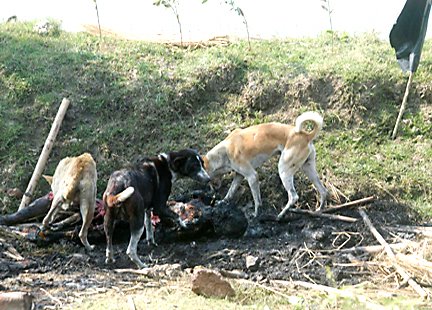
हम एक लोकतंत्र में रह रहे हैं! 14 मार्च को हुई घटना और उसके बाद सीपीएम के बंद के दौरान गायब हुए दो सौ लोगों का अब तक कोई अता-पता नहीं है्. हां। कुछ लाशें हैं जो इलाके में इस हालत में पायी गयी हैं. क्या हम बता सकते हैं कि इन्होंने किस बात की कीमत चुकायी? क्या हम इसको लेकर आश्वस्त रह सकते हं कि हमें भी कभी ऐसी ही कीमत नहीं चुकानी पड़ेगी?
Subscribe to:
Post Comments (Atom)
नंदीग्राम पर नयी फ़िल्म
यह फ़िल्म 14 मार्च की घटनाओं के सूक्ष्म विवरण के साथ आयी है.
देखें : नव उदारवाद का नया चेहरा बजरिये नंदीग्राम
देखें : विकास के नाम पर लोगों के उजड़ने की कहानी
उन्होंने मेरे पिता को टुकडों में काट डाला
देखें : न हन्यते
नंदीग्राम में 100 से ज्यादा लोग मारे गये हैं, 200 अब भी लापता हैं. वहां महिलाओं के साथ सीपीएम के कैडरों ने बलात्कार किया. बच्चों तक को नहीं छोड़ा गया है. सीपीएम की इस क्रूरता और निर्लज्जता का विरोध होना चाहिए. हमें नंदीग्राम, सिंगूर और हर उस जगह के किसानों के आंदोलन का समर्थन करना चाहिए, जो अपनी जमीन बचाने के लिए लड़ाई लड़ रहे हैं. यह दस्तावेज़ी फ़िल्म किसानों के इसी संघर्ष के बारे में है. यह फ़िल्म नंदीग्राम के ताज़ा नरसंहार से पहले बनायी गयी थी.
नंदीग्राम में जनसंहार के बाद के द्श्य
यह फिल्म पुलिस द्वारा नंदीग्राम में बर्बर तरीके से की गयी हत्याओं एवं उनकी भयावहता व बर्बरता के बारे में है. इसके कई दृ़श्य विचलित कर देनेवाले हैं.
नंदीग्राम प्रतिरोध्
नंदीग्राम में सरकारी आतंक
देखें : माकपा की गुंडागर्दी
नंदीग्राम में सीपीएम सरकार की पुलिस ने जो बर्बर कार्रवाई की, वह अब खुल कर सामने आने लगी है. यह फ़िल्म उसी बर्बरता के बारे में है. इसके कई दृश्य आपको विचलित कर सकते हैं. आप इसे तभी देखें जब आप वीभत्स दृश्य देख सकने की क्षमता रखते हों. हम खुद शर्मिंदा हैं कि हमें ऐसे दृश्य आपको दिखाने पड़ रहे हैं, पर ये आज की हकीकत हैं. इनसे कैसे मुंह मोडा़ जा सकता है?
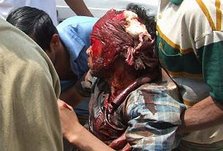
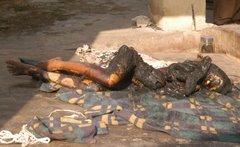
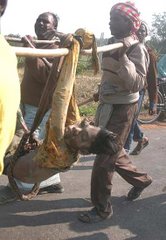
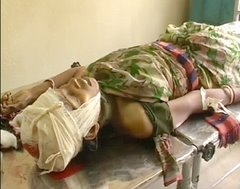

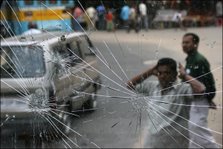
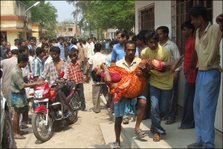

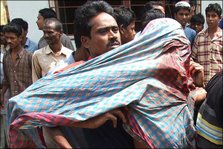


No comments:
Post a Comment